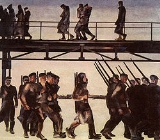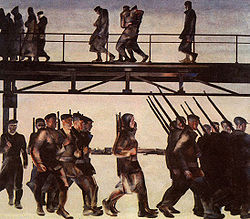
Alexander Deyneka
Encyclopedia
Aleksandr Aleksandrovich Deyneka ' onMouseout='HidePop("96402")' href="/topics/Kursk">Kursk
- June 12, 1969, Moscow
) was a Soviet
Russian
painter, graphic artist and sculptor, regarded as one of the most important Russian modernist figurative painters of the first half of the 20th century.
He studied at Kharkov Art College (pupil of Alexander Lubimov) and at VKhUTEMAS
. He was a founding member of groups such as OST
and Oktyabr, and his work gained wide exposure in major exhibitions. His paintings and drawings (the earliest are often monochrome
due to the shortage of art supplies) depict genre scenes as well as labour and often sports. Deyneka later began painting monumental works, such as The Defence of Petrograd in 1928, which remains his most iconic painting, and The Battle of Sevastopol
in 1942, The Outskirts of Moscow. November 1941 and The Shot-Down Ace.
His mosaic
s are a feature of Mayakovskaya metro station in Moscow. He was awarded the Order of Lenin
and the Order of the Red Banner of Labor.
He is buried in the Novodevichy Cemetery
in Moscow.
He is in the highest category "1A - a world famous artist" in "United Artists Rating
".


Kursk
Kursk is a city and the administrative center of Kursk Oblast, Russia, located at the confluence of the Kur, Tuskar, and Seym Rivers. The area around Kursk was site of a turning point in the Russian-German struggle during World War II and the site of the largest tank battle in history...
- June 12, 1969, Moscow
Moscow
Moscow is the capital, the most populous city, and the most populous federal subject of Russia. The city is a major political, economic, cultural, scientific, religious, financial, educational, and transportation centre of Russia and the continent...
) was a Soviet
Soviet Union
The Soviet Union , officially the Union of Soviet Socialist Republics , was a constitutionally socialist state that existed in Eurasia between 1922 and 1991....
Russian
Russians
The Russian people are an East Slavic ethnic group native to Russia, speaking the Russian language and primarily living in Russia and neighboring countries....
painter, graphic artist and sculptor, regarded as one of the most important Russian modernist figurative painters of the first half of the 20th century.
He studied at Kharkov Art College (pupil of Alexander Lubimov) and at VKhUTEMAS
VKhUTEMAS
Vkhutemas ) was the Russian state art and technical school founded in 1920 in Moscow, replacing the Moscow Svomas. The workshops were established by a decree from Vladimir Lenin with the intentions, in the words of the Soviet government, "to prepare master artists of the highest qualifications for...
. He was a founding member of groups such as OST
OST
- Music :* Original Soundtrack, the soundtrack of a movie, TV series, or video game.* Open Source Track, a licensing and distribution model for music initiative* The alias of electronic musician Chris Douglas- Science and technology :...
and Oktyabr, and his work gained wide exposure in major exhibitions. His paintings and drawings (the earliest are often monochrome
Monochrome
Monochrome describes paintings, drawings, design, or photographs in one color or shades of one color. A monochromatic object or image has colors in shades of limited colors or hues. Images using only shades of grey are called grayscale or black-and-white...
due to the shortage of art supplies) depict genre scenes as well as labour and often sports. Deyneka later began painting monumental works, such as The Defence of Petrograd in 1928, which remains his most iconic painting, and The Battle of Sevastopol
Battle of Sevastopol
The Siege of Sevastopol took place on the Eastern Front of the Second World War. The campaign was fought by the Axis powers of Germany, Romania and Italy against the Soviet Union for control of Sevastopol, a port in Crimea on the Black Sea. On 22 June 1941 the Axis invaded the Soviet Union under...
in 1942, The Outskirts of Moscow. November 1941 and The Shot-Down Ace.
His mosaic
Mosaic
Mosaic is the art of creating images with an assemblage of small pieces of colored glass, stone, or other materials. It may be a technique of decorative art, an aspect of interior decoration, or of cultural and spiritual significance as in a cathedral...
s are a feature of Mayakovskaya metro station in Moscow. He was awarded the Order of Lenin
Order of Lenin
The Order of Lenin , named after the leader of the Russian October Revolution, was the highest decoration bestowed by the Soviet Union...
and the Order of the Red Banner of Labor.
He is buried in the Novodevichy Cemetery
Novodevichy Cemetery
Novodevichy Cemetery is the most famous cemetery in Moscow, Russia. It is next to the 16th-century Novodevichy Convent, which is the city's third most popular tourist site. It should not be confused with the Novodevichy Cemetery in Saint Petersburg....
in Moscow.
He is in the highest category "1A - a world famous artist" in "United Artists Rating
United Artists Rating
“United Art Rating” — rating, published since 1999 by Artists Trade Union of Russia; one of instruments of art market regulations.- About :“United Art Rating” is published as a periodical reference book, registered as mass media.XVII edition of the reference book includes the names, dates of life...
".
Works


- «Three Women's Figures», 1920s
- «The Cabaret», 1921
- «Перед спуском в шахту», 1924
- «Football», 1924
- «After the Rain. Kursk», 1925
- «Springtime», 1925
- «The Skiers», 1926
- «Tennis», 1926
- «На стройке новых цехов», 1926
- «Textile Workers», 1927
- «The Ode to the Spring», 1927
- «The Defense of Petrograd», 1928, Central Museum of the Defense Forces of the USSR, Moscow
- «Механизируем Донбасс!» (poster), 1930
- «Китай на пути освобождения от империализма» (poster), 1930
- «Надо стать самим специалистами» (poster), 1930
- «Book Cover», 1931
- «The Interventionists' Mercenary», 1931
- «On the Balcony», 1931
- «Crosscountry Race», 1931
- «A Girl at the Window. Winter», 1931
- «Mother», 1932, ГТГ
- «Soccer Game», 1932
- «The Sleeping Boy With Cornflowers», 1932
- «Noon», 1932
- «The Soccer Player», 1932
- «Кто кого?», 1932
- «In the Airs», 1932
- «The Night Landscape with Horses and Dry Grasses», 1933
- «Girls Swimming», 1933
- «Dry Leaves», 1933
- «Resting Children», 1933
- «Communists at Interrogation», 1933
- «Физкультурница" / "Работать, строить и не ныть!» (poster), 1933
- «Without Work in Berlin», 1933
- «The Pier», 1933
- «The Race», 1933
- «Runners», 1934
- «Skiers», 1934
- «Landscape with a Herd», 1934
- «Goalkeeper», 1934
- «A Pioneer. Kursk», 1934
- «Crimean Pioneers», 1934
- «A Parachuter above the Sea», 1934
- «Quirinal Place, Rome», 1934
- «Spanish Stairways», 1934
- «A Street in Rome»
- «Monks», 1935
- «An Italian motif», 1935
- «The Park», 1935
- «The Portrait of S.I.L. with the Straw Hat», 1935
- «Tuileries», 1935
- «Quai de la Seine», 1935
- «Paris. In a Café», 1935
- «Une parisienne», 1935
- «Негритянский концерт», 1935
- «The Night (detail)», 1935
- «The Boredom», 1935
- «The Road to Mount-Vernon», 1935
- «Collective Farmer on a Bicycle», 1935
- «A Lunch Break in Donbass», 1935
- «Первая пятилетка», 1936
- «The Model», 1936
- «The Future Pilots», 1937
- «The Stakhanovites», 1937
- «Woman in Red», 1939
- «The Lilacs»
- «Nikitka – The First Russian Pilot», 1940
- «The Left March», 1941
- «The Outskirts of Moscow. November 1941»
- «Sverdlov Place in December 1941»
- «Evening. The Patriarch Ponds, 1941»
- «A Burned down Village», 1942
- «Эвакуация колхозного скота»
- «Колхозницы роют противотанковые рвы на подступах к Москве»
- «Ремонт танков на прифронтовом заводе»
- «Танки идут на фронт»
- «Наступление началось»
- «The Defense of Sebastopol», 1942
- «The Knocked down Ace», 1943
- «Nude Woman Sitting», 1943
- «Under Occupation», 1944
- «Expanse», 1944
- «Above the Devastated Berlin», 1944
- «Berlin. The Day of the Declaration», 1945
- «A Stadium in Berlin», 1945
- «Near Kursk. Tuskor' River», 1945
- «Relay Race» (sculpture), 1945
- «A Boxer» (sculpture), 1947
- «100-meter Race» (sculpture), 1947
- «The Relay Race on the Ring B», 1947
- «Donbass», 1947
- «The Studio Window», 1947
- «In Sebastopol», 1947
- «Self-portrait», 1948
- «The Space of Building Sites under Moscow», 1949
- «The Skiers» (mosaic), 1950
- «Football Players» (sculpture), 1950
- «Перед забегом» (sculpture), 1951
- «A Nude Girl», 1951
- «Дачный поселок Кратово», 1951
- «In Sebastopol», 1947
- «On the Skating Rink in Kratovo», 1951
- «The Snow Maiden», 1954
- «The Laying Woman with a Ball», 1954
- «Still Life. Strawberries», 1955
- «A Nude Model», 1955
- «Football players» (sculpture), 1955
- «The Tractor Driver», 1956
- «In Sebastopol», 1956
- «Near the Sea», 1956-1957
- «Putting the Shot» (sculpture), 1957
- «Голова парашютиста» (mosaic), 1957
- «A Nice Morning» (mosaic), 1959-1960
- «Hockey Players» (mosaic), 1959-1960
- «October Slogans of Peace by the Nevsky Gate, 1960
- «A Milker» (mosaic), 1962
- «The Red Guardsman» (mosaic), 1962
- «A Villa in Rome», 1965
- «The Young Designer», 1966
- «In the South (detail)», 1966
- «Владимир Маяковский в РОСТА»
- «Летнее приволье»
- «Running Sportswoman» (sculpture)
- «The Cat and the Cook»

